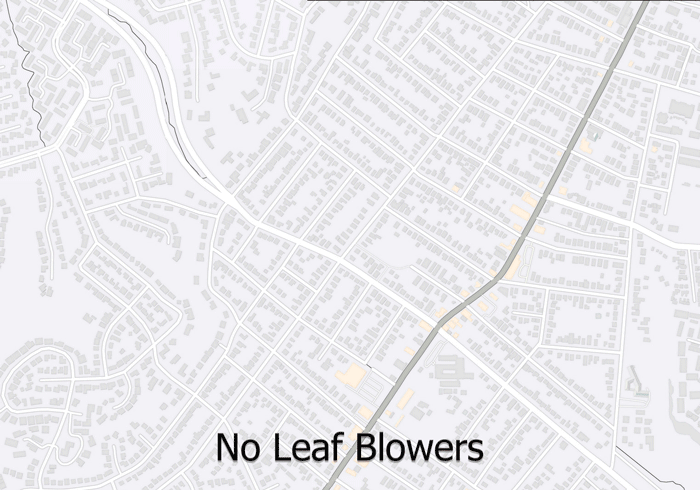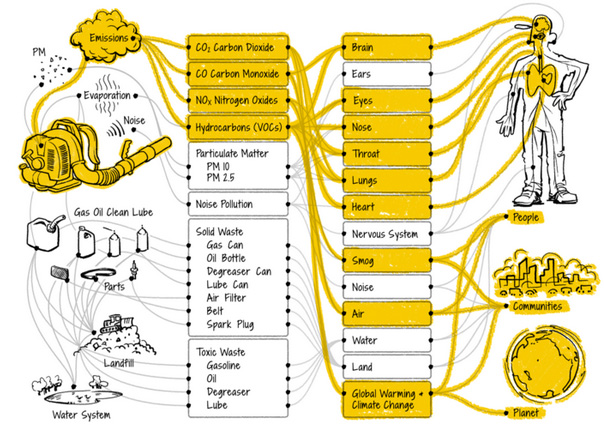Gas-powered leaf blowers are used far too often and their effects really blow: intense noise and major health and environmental impacts.


On this page:
Noise
Health Impacts
Environmental Impacts
References
Noise
Noise is not just a nuisance–it impacts our work, our communications, our mental health, our stress levels, our physical health, our children’s ability to study, and much more.
Some neighborhood noise is unavoidable. But gas leaf blowers run throughout the day, their noise is extreme, and their low-frequency sound waves travel farther than those of battery blowers and easily penetrate windows, disrupting daily life in homes, offices, hospitals, classrooms, and more. When leaf blowers are used to tidy some people’s properties, everyone else pays the price.
Visualize It
You might think a leaf blower just annoys a few neighbors for a few minutes. But the noise travels several city blocks, in all directions. This map shows how just three leaf blowers impact hundreds of households. Yet a typical area this size will see many more leaf blowers on any given day, and often several at once, creating an inescapable cacophony disturbing residents repeatedly throughout the day, even within the walls of their homes.

The noise disturbs me in my back yard, penetrates the walls of my home, interrupts my kids’ studying … Our home is our refuge and these machines intrude on my property and my family.
– Santa Cruz resident/petition signer
Read C.H.A.S.E.’s summary report on The Science on the Health Consequences of Noise
Health Impacts
Exhaust
Two-stroke leaf blower exhaust is worse than a truck’s in many ways. More than 30% of its fuel/oil mixture gets emitted as an aerosol, unburned. This contains a host of toxins, and carcinogens. Benzene, 1,3-butadiene, acetaldehyde, and formaldehyde increase the risk of a range of health problems, including:
- eye, skin, and respiratory tract irritation
- neurological effects
- lymphoma, leukemia, and other types of cancer
That’s just the start of it. They also emit hydrocarbons, nitrogen dioxide, and carbon monoxide, which mix with sunlight to create ground-level ozone, which can cause airway constriction, coughing, sore throat, shortness of breath, emphysema, bronchitis, and asthma. Carbon monoxide exposure can cause both mild and serious effects, from headaches, dizziness, weakness, and nausea to vomiting, disorientation, and worse.
Then there’s the fine particulates (PM2.5), which lodge deep inside the lungs, causing or exacerbating asthma and other respiratory problems and increasing the risks of heart attacks, strokes, arrythmia, and heart failure. The manufacturers don’t deny this, and advise people to use their blowers in a “well-ventilated area.” But first, workers will be inhaling high concentrations of all this, and then when it’s “blown away,” it doesn’t disappear–“away” means towards other people. It enters houses, workplaces and schools through open windows. Larger particulates can float in the air for hours to days, and fine particulates stay suspended in the air we breathe for as long as a week or more. Their concentrations decline over distance, but leaf blowers and other gas tools are constantly adding more, day after day, throughout the city. Exposure to elevated PM levels over the long term can reduce life expectancy by several years.
All these health impacts are even more serious for children, the elderly, people with pre-existing conditions, and of course, those who operate them.
Noise
Leaf blowers are loud, but even at a distance, their noise raises levels of stress hormones like cortisol, increasing anxiety, cognitive impairment, and the propensity for hostile behavior, elevating blood pressure and the risk of cardiovascular diseases, and compromising the immune system.
Hearing loss is a big risk for anyone who operates a gas-powered leaf blower, but anyone else in an area where leaf blowers are used is also at risk because hearing loss is a function of both noise intensity and its duration.

Impacts on Landscape Workers

The operators of gas leaf blowers are exposed to the same long list of health risks as residents, but at much higher levels. At “ground zero,” the worker faces extremely high concentrations of carbon monoxide and particulate matter and extreme and prolonged noise exposure. Their risk of developing cancer is potentially double. *
Landscape workers face unequal burdens cleaning our yards and parks, and often, limited economic options. Requiring their employers to switch to cleaner equipment is a matter of basic equity, workplace safety, health, and environmental justice and it’s long overdue.
“Switching to battery-powered blowers and weed whips was the best thing I could have done for my workers.” -Arturo Valdivia, Public Services Supervisor, City of Coronado
*Source: CA Air Resources Board, 2018
I”t’s pretty bad. You have to be smelling that smoke all the time, and it can cause you a lot of health problems, allergies and getting sick all the time.”
-Noe Bautista, Bautista’s Landscaping, from KQED News
“If you have never worn a two stroke leaf blower on your back, it is hard to imagine the effect the noise, exhaust and dust has on you after hours of use. It is a singular form of trauma for your ears and lungs.”
– Ken Foster, Santa Cruz landscaper, who switched from gas to electric blowers in 1988, and has used only manual tools since 1999
Environmental Impacts
You might think a small machine would have small effects. But the gas-powered leaf blower is a little engine with big impacts on our air, soils, and water.
Leaf blowers emit outsized levels of hydrocarbons from burned and unburned fuel, carbon monoxide, nitrogen oxides, and reactive organic gases. These go on to form low-level ozone, which causes the much-reviled brown smog that hovers over cities. And nitrogen oxides contribute to acid rain. Thanks to evaporation, leaf blowers even pollute while they’re off, sitting unused.


Meet the Ford Raptor, a 6.2 liter, V8 truck weighing 6,200 lbs. Just one half-hour of running a leaf blower releases the same amount of hydrocarbons as driving a Raptor from north Texas to Anchorage, Alaska—3,887 miles. (Edmunds.com)
How can that be? Over time, we’ve gotten better at reducing some of the emissions from cars and trucks, but we still don’t regulate off-road engines very much. In fact, 2020 is the year that the CA Air Resources Board estimates smog-forming emissions of small off-road engines, like leaf blowers, will surpass those of light-duty passenger cars.
And when it comes to climate change, cities are searching for ways to reduce their output of greenhouse gases, and the easiest sources to target are those most easily replaced by other technologies and that cost the least to do so. Electric leaf blowers can do the same job as gas blowers for the same cost of equipment and lower long-term costs of power and maintenance. This is low-hanging fruit that the city should be eager to pluck for easy and immediate reductions to our greenhouse gas emissions.
As for the landscapes that leaf blowers are supposed to “clean up” …
- They blow away leaves, but also any mulch and all kinds of organic matter needed for healthy soil–and they blow away a lot of soil, too! The loss of protective cover exposes plants to pathogens and diseases.
- They disturb and displace beneficial insects and critters important to healthy gardens and ecosystems. Many birds, for example, depend on the insects found in the leaf litter layer to feed their young.
- They disperse chemicals, fertilizers, and pesticides that are already present on the ground into the air, sending them to other people’s yards and houses, and onto the street, where rain carries them to the ocean.
It’s hard to think of another technology so outdated, with such extreme impacts on our health and environment, that has existing, superior alternatives, yet is still widely used all around us. Like removing lead from gasoline and paint, when cost-effective alternatives are available, there’s no reason to delay any longer–when those cleaner alternatives are finally widespread, we wonder why we ever held on to the dirty ones so long.
References
Babisch W. The noise/stress concept, risk assessment and research needs. Noise Health. 2002; 4:1-11.
Basner, Mathius, et al. Auditory and non-auditory effects of noise on health. Lancet. 2014; Apr 12; 383(9925): 1325–1332.
Brook, et al. Particulate Matter Air Pollution and Cardiovascular Disease. Circulation. 2010; June; 2331-2378.
Davies H, Kamp IV. Noise and cardiovascular disease: A review of the literature 2008-2011. Noise Health. 2012;14:287-91.
Ebrecht M, Hextall J, Kirtley LG, Taylor A, Dyson M, Weinman J. Perceived stress and cortisol levels predict speed of wound healing in healthy male adults. Psychoneuroendocrinology. 2004, July. 29 (6): 798–809.
European Environment Agency. Noise in Europe 2014. 2014; Publications Office of the European Union.
Fritschi L, Brown AL, Kim R, Schwela DH, Kephalopoulos S, eds. Burden of disease from environmental noise. Bonn: World Health Organization; 2011.
Goines, L, Hagler, L. Noise Pollution: A Modern Plague. Southern Medical Journal. 2007; Mar. Vol. 100, N. 3.
Hygge, S, Evans, G W, Bullinger, M. Chronic Noise Exposure and Physiological Response: A Prospective Study of Children Living Under Environmental Stress. Psychological Science. 1998; Jan 1; 9:75-77.
Ising H, Babisch W, Kruppa B. Noise-induced endocrine effects and cardiovascular risk. Noise Health. 1999;1:37-48.
Karpa MJ, Gopinath B, Beath K, et al. Associations between hearing impairment and mortality risk in older persons: the Blue Mountains Hearing Study. Ann Epidemiol. 2010;20:452–59.
Pasanen, T, Rytkönen, E, Sorainen, E. Leaf Blower Noise. Kuopio Regional Institute of Occupational Health Acoustics Laboratory. Presented at Joint Baltic-Nordic Acoustics Meeting 2004, 8-10 June, Mariehamn, Åland, Finland.
Pollock, C, Sparks, J, Banks, JL. Lawn and Garden Equipment Sound: A Comparison of Gas and Battery Electric Equipment. Journal of Environmental and Toxicological Studies. 2018; Dec 4. Vol. 3, Iss. 1.
Passchier-Vermeer, W, Passchier, W F. Noise exposure and public health. Environmental Health Perspectives. 2000 Mar; 108(Suppl 1): 123–131.
Quiet Clean D.C. Testimony of Chris Pollock, ARUP. From the D.C. Council, Committee of the Whole, Hearing on Leaf Blower Legislation, Bill 22-234, July 2, 2018.
Sheffield, Perry, MD, et al. Medical Grounds for a Restriction on Internal Combustion Power Tools and Leaf Blowers. Letter to Eastchester Town Board from Mount Sinai Hospital Pediatric Environmental Health Specialty Unit, 2010; Apr. 22.
Stansfeld, Stephen A, Matheson, Mark P. Noise pollution: non-auditory effects on health. British Medical Bulletin. 2003; Dec 1. Volume 68, Issue 1, Pages 243–257.
K. Straif, et al. Air Pollution and Cancer. Scientific Publication 161, International Agency for Research on Cancer, World Health Organization. 2013.

